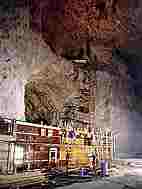
Technical information – specifications
Gj¢vik Olympic Mountain Hall is the worlds largest hall - for public use - and also technically unique.
Dimensions ;
61x91x25 meters
Seating capasity ; 5830
Net area ; 10.010
Cross area ; 14910
Total cost ; MNOK 135,0
Stadium ; 1965 m2
THE BLASTING
Blasting for the cavern required several points of attack in order to extract the rock in a rational way. The first tunnel entered the main cavern hall some 10 meters below the roof. The roof area was then freed by blasting, section by section, towards the opposite end of the tunnel, while bolting and securing the roof as the work progressed. 170 tons of dynamite were used during the blasting. The shock waves were continually monitored. The effect of the blasting on the rock above the cavern was monitored by deformation gauges in a number of drillholes, together with precise measurements on the ground surface.
PILOT STUDIES
The underground cavern was carved out of gneis, which may have been formed as many as 800 – 1.100 million yers ago. This type of rock is known for being well-suited to the construction of underground facilities. Before work on the underground cavern began extensive geological surveys were carried out.
Core-drilling was carried out to obtain rock samples. Other work included laboratory tests of the different rock types, measuring the stresses and strains in the mountain as well as geophysical measurements. The underground cavern was modelled on a computer to predetermine the effects on the rock around the cavern during the blasting process.
During the period of construction rock movements above the cavern were continously measured, and the mountain was seen to «settle» by 8 – 10mm, corresponding closely to the computer model.




